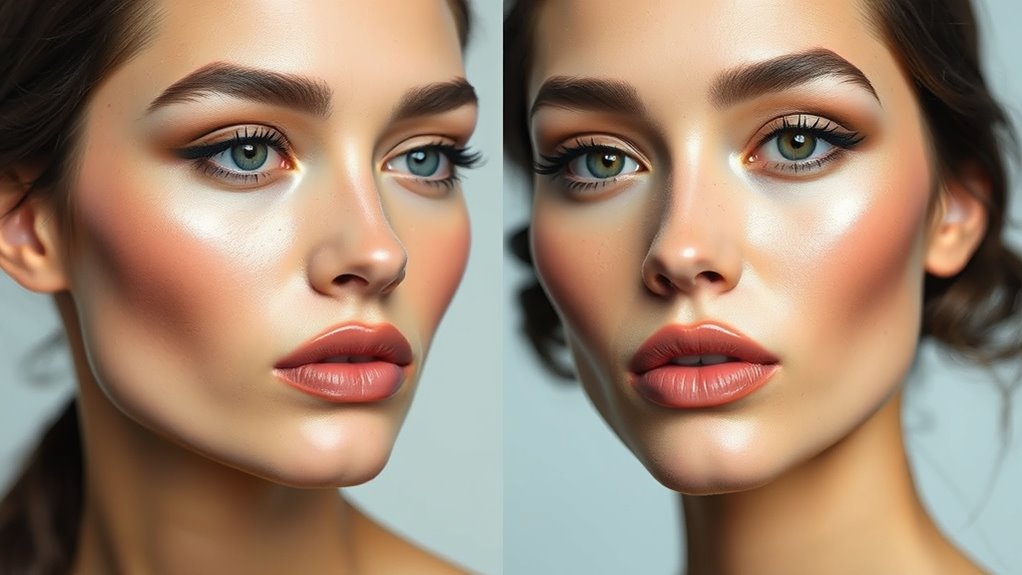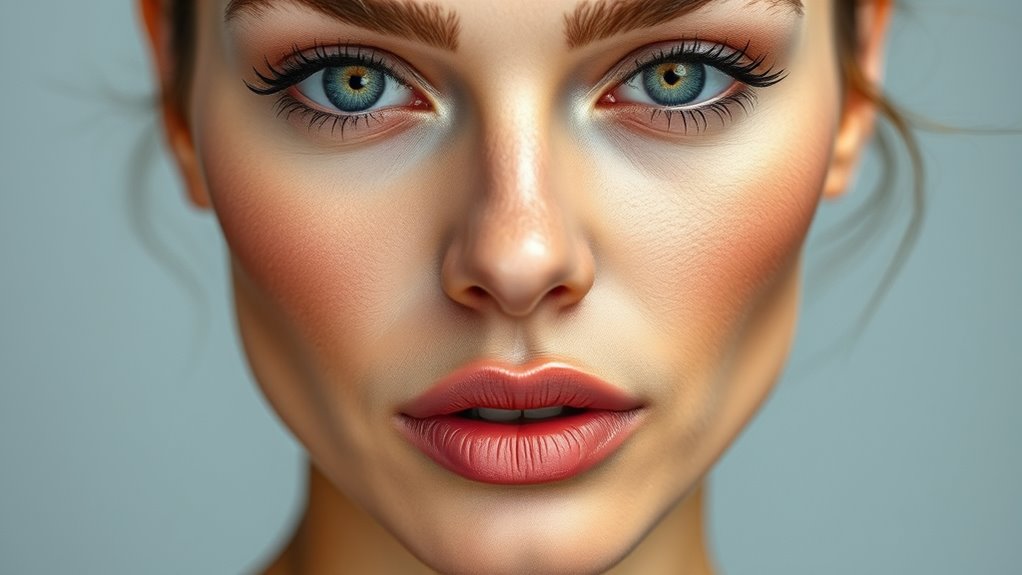Sculpting and contouring both enhance your facial features but serve different purposes. Contouring adds shadows to specific areas like cheekbones and jawline to create definition, often using makeup or cosmetic procedures. Sculpting focuses on reshaping broader facial structures for harmony and balance, sometimes involving lifts or implants. Understanding these differences helps you choose the right approach. Exploring further reveals how to effectively apply each technique for natural, stunning results.
Key Takeaways
- Contouring creates shadows to define features, while sculpting involves broader reshaping for facial harmony.
- Contouring uses makeup products to enhance natural bone structure; sculpting often involves invasive procedures or treatments.
- Blending is essential in contouring for natural shadows, whereas sculpting emphasizes overall facial balance and proportion.
- Cosmetic contouring techniques include fillers, while sculpting may involve lifts or implants for permanent reshaping.
- Both techniques can be combined or used separately to achieve personalized aesthetic goals.

When it comes to enhancing your facial features, understanding the difference between sculpting and contouring is essential. These techniques are often used in makeup routines and cosmetic procedures to define, reshape, or highlight specific areas of your face. While they may seem similar, they serve distinct purposes and require different approaches. Knowing how each works can help you achieve the look you want, whether you’re doing your makeup at home or considering professional cosmetic procedures.
Contouring is primarily about creating shadows on your face to add dimension, depth, and a more sculpted appearance. It involves applying darker shades to areas you want to recede, such as the sides of your nose, under your cheekbones, or along your jawline. The goal is to mimic natural shadowing, giving your face a more chiseled look or balancing asymmetries. Makeup techniques for contouring are straightforward: you use a contour stick, powder, or cream, blending well to avoid harsh lines. When done correctly, contouring enhances your natural bone structure, making certain features stand out more prominently. In cosmetic procedures, contouring can also refer to non-invasive treatments like fillers, which temporarily reshape or add volume to targeted areas, providing a more defined look without surgery.
Contouring creates shadows to define features, enhancing natural bone structure and balancing facial asymmetries.
Sculpting, on the other hand, tends to be a more detailed process—whether in makeup or cosmetic procedures—aimed at creating a harmonious, balanced face. It involves more than just adding shadows; it’s about refining the overall structure by accentuating your best features and subtly reshaping others. Makeup techniques for sculpting often include a combination of highlighting and contouring, emphasizing your cheekbones, jawline, and brow bones with strategic placement of light and dark shades. In cosmetic procedures, sculpting might involve procedures like contouring facelifts or cheek implants designed to lift, tighten, or reshape facial contours. The intent is to produce a natural, youthful appearance that enhances your unique features. Additionally, understanding the best tools and techniques can significantly improve your results.
The key difference lies in the scope and intent: contouring is about adding shadow to define specific areas, while sculpting involves a broader approach to reshaping and harmonizing your facial features. Both techniques can be used separately or together to achieve your desired aesthetic. When you’re exploring cosmetic procedures, understanding this distinction helps you communicate your goals with your specialist. Whether you’re using makeup techniques at home or considering professional treatments, mastering the art of contouring and sculpting allows you to enhance your natural beauty with precision and confidence.
Frequently Asked Questions
Can Sculpting or Contouring Be Done at Home Safely?
Yes, you can safely do DIY methods of sculpting or contouring at home if you follow proper precautions. Use quality products, avoid sharp tools, and always do a patch test first. However, for more dramatic or precise results, professional procedures are safer. Remember, attempting complex techniques without proper training can cause damage. When in doubt, consult a professional to ensure safety and achieve the best outcome.
Which Method Offers Longer-Lasting Results?
You’ll find that sculpting offers longer-lasting results than contouring, mainly because it involves more permanent procedures like fillers or surgical options. While contouring provides temporary enhancements, maintaining long-term effects from sculpting requires consistent maintenance routines, such as follow-up treatments or skincare. If you prefer lasting changes, investing in sculpting methods is smarter, but remember, they often demand more commitment and professional oversight.
Are There Any Skin Types That Shouldn’T Undergo These Procedures?
If you have sensitive skin or certain skin conditions like eczema or psoriasis, you should be cautious with sculpting or contouring procedures. These treatments can sometimes irritate or worsen skin issues. Always consult a dermatologist beforehand to assess your skin’s sensitivity and suitability. They can recommend safer options or adjustments to minimize risks, ensuring your skin stays healthy and protected during any cosmetic procedure.
How Do I Choose Between Sculpting and Contouring for My Face?
Ever wonder how to enhance your facial structure perfectly? To choose between sculpting and contouring, consider your face’s natural features and your makeup goals. Sculpting creates a more dramatic, defined look, ideal for chiseled features or special occasions. Contouring offers a subtle enhancement for everyday wear. Think about whether you want a bold transformation or a natural glow, and select the technique that best aligns with your makeup application style.
What Are the Potential Risks or Side Effects of Each Technique?
You should be aware that both sculpting and contouring can cause potential allergies or skin irritation, especially if you use products with harsh chemicals or fragrances. Always patch-test new products before applying them broadly. Overuse or applying too much pressure can also lead to skin sensitivity or irritation. To minimize risks, choose high-quality, hypoallergenic products and follow proper application techniques, and consult a dermatologist if you experience persistent issues.
Conclusion
Understanding the difference between sculpting and contouring helps you enhance your natural features effectively. Did you know that 80% of people who try contouring report feeling more confident? Whether you choose to sculpt or contour, remember that practice makes perfect. With the right techniques, you can achieve a more defined, polished look that boosts your self-esteem. So go ahead—experiment and find what works best for you!









